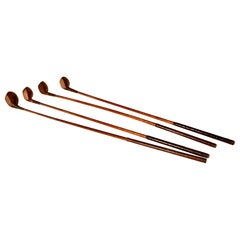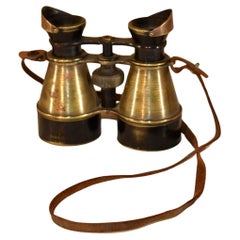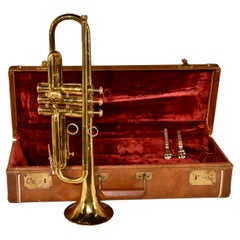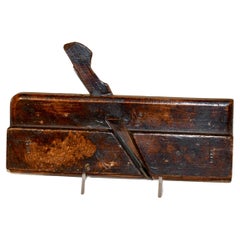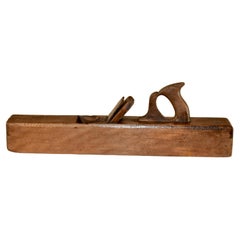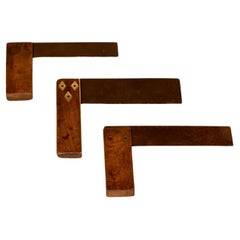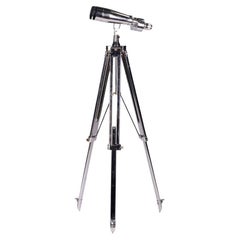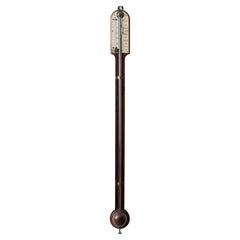Black Sheep Antiques Collectibles and Curiosities
to
10
10
4
1
1
1
6
3
1
2
1
1
8
6
5
4
2
9
7
7
2
1
10
10
10
Set of Four Vintage Golf Clubs, Circa 1930-1940's
Located in High Point, NC
Set of four vintage golf woods, circa 1930-1940's. The clubs are each unique and have been used well throughout the years, giving them a wonderful color and use pattern. The shafts...
Category
Vintage 1930s English Sports Equipment and Memorabilia
Materials
Hickory
Pair of Brass Field Binoculars by W. Watson &. Sons of London
Located in High Point, NC
Pair of wonderfully aged brass field binoculars with moveable brass eye shields, which help to give clearer views without additional light coming through the sides. This pair of bin...
Category
Vintage 1910s English Scientific Instruments
Materials
Brass
F E Olds & Son Ambassador Trumpet, circa 1952
Located in High Point, NC
F E Olds & Son Ambassador trumpet in original case. The trumpet measures 19 L x 4.38 D x 6 H. The trumpet was made in Los Angeles and the serial number is 81069, which dates its pr...
Category
Mid-20th Century American Musical Instruments
Materials
Brass
19th Century English Molding Plane
Located in High Point, NC
19th century molding plane made from beech wood. The plane is stamped with the name MIKE. Imagine the moldings this plane was used to make.....
Category
Antique 19th Century English Industrial Scientific Instruments
Materials
Beech
19th Century Trying or Jointer Plane
Located in High Point, NC
19th century trying or jointer plane from England. Lovely patina from age and use.
Category
Antique 19th Century English Victorian Scientific Instruments
Materials
Metal
19th Century Set of 3 Victorian Set Squares
Located in High Point, NC
This is a set of three antique shipwright's set squares. The squares are made from oak and have brass caps. They are right-angled tools, dating to the Victorian period, circa 1880. ...
Category
Antique 19th Century English Victorian Scientific Instruments
Materials
Brass
Set of Three Victorian Set Squares, C. 1880
Located in High Point, NC
This is a set of three antique shipwright's set squares. The squares are made from oak and have brass caps. They are right-angled tools, dating to the Victorian period, circa 1880. ...
Category
Antique 19th Century English Victorian Scientific Instruments
Materials
Brass
Set of Three Victorian Set Squares, C. 1880
Located in High Point, NC
This is a set of three antique shipwright's set squares. The squares are made from rosewood and have brass caps. They are right-angled tools, dating to the Victorian period, circa 1...
Category
Antique 19th Century English Victorian Scientific Instruments
Materials
Brass, Steel
19th Century French Chestnut Diminutive Armoire
Located in High Point, NC
19th century chestnut miniature armoire from France. This is a wonderful piece of craftmanship, with a lovely crown following down to a case which is entirely raised panelled and peg...
Category
Antique Early 19th Century French French Provincial Models and Miniatures
Materials
Chestnut
18th Century French Miniature Chest of Chestnut
Located in High Point, NC
18th century rare French carpenter's sample made of chestnut wood. It has three drawers with each a kings wood inlay central design. Lovely pegged construction, supported on a lovely...
Category
Antique 18th Century French Louis XV Models and Miniatures
Materials
Chestnut
Related Items
Navy Binoculars
Located in Paris, FR
Binoculars Navy with polished steel adjustable tripod base.
With polished aluminium and steel binoculars with clear glass
lens, magnifying x8 times. Adjust...
Category
21st Century and Contemporary Indian Nautical Objects
Materials
Aluminum, Steel
English Stick Barometer by Loftus, London, 19th Century
Located in Savannah, GA
A late 19th century rosewood stick barometer by Loftus of London.
3 ¼ inches wide by 36 inches tall; 3 inches deep
Category
Antique 19th Century English Scientific Instruments
Materials
Rosewood
20th Century Japanese Pair Of Naval Bridge "Big Eye" Binoculars By Nikon c.1940
By Nikon
Located in Royal Tunbridge Wells, Kent
A rare 20th Century set of Japanese naval bridge “big eye“ binoculars by Nikon manufactured during WWII by Tokyo Kogaku Kikai (Tokyo Optical Company). They have been expertly cleaned...
Category
20th Century Japanese Other Scientific Instruments
Materials
Metal
$10,273 / set
H 42.13 in W 8.27 in D 19.3 in
Antique French Lorgnette Binoculars or Opera Glasses in Brass & Mother of Pearl
By LeRoy
Located in Hamilton, Ontario
This pair of antique lorgnette opera glasses were made by LeRoy of France in approximately 1880 in the period Victorian style. These bi...
Category
Antique Late 19th Century French Victorian Scientific Instruments
Materials
Brass
$699
H 1.5 in W 8.75 in D 1.75 in
Michigan State Spartans Football 1952 Calendar
Located in Garnerville, NY
Straight from the Spartan alumnus and their estate. Graduating in 1952 in Graphic Arts, he was a rabid sports fan. This calendar was procured from his study. Green graphics on heavie...
Category
Vintage 1950s American Sporting Art Sports Equipment and Memorabilia
Materials
Paper
Rare 19th Century English Tunbridgeware Hair Pin or Slide
Located in Dallas, TX
PRESENTING an EXTREMELY UNIQUE and RARE 19C British Tunbridgeware Hair Pin/Bobbin or Slide.
This slide is unlike any of it’s kind we have seen before, it is a VERY RARE survivor.
From circa 1860 – 80 and made in Tunbridge Wells, England.
Made of walnut with gorgeous marquetry inlay on the entirety of the front with classic Tunbridgeware micro-mosaic all over the front. The rear is walnut.
The marquetry inlay appears to be various different woods, namely, maple, walnut and satinwood.
Would have been worn in a Lady’s hair bun with the micro-mosaic facing forward.
This would have belonged to a VERY ELEGANT LADY in the mid to late 19th Century.
Tunbridge ware is a form of decoratively inlaid woodwork, typically in the form of boxes, that is characteristic of Tonbridge and the spa town of Royal Tunbridge Wells in Kent in the 18th and 19th centuries. The decoration typically consists of a mosaic of many very small pieces of different coloured woods that form a pictorial vignette. Shaped rods and slivers of wood were first carefully glued together, then cut into many thin slices of identical pictorial veneer with a fine saw. Elaborately striped and feathered bandings for framing were pre-formed in a similar fashion.
There is a collection of Tunbridge ware in the Tunbridge Wells Museum and Art Gallery in Tunbridge Wells.
The famous makers of Tunbridge ware were in the Tunbridge Wells area of Kent; their most notable work was from circa 1830-1900.
Early makers of Tunbridge ware, in Tunbridge Wells in the mid-18th century, were the Burrows family, and Fenner and Co. In the 19th century, around 1830, James Burrows invented a technique of creating mosaics from wooden tesserae. Henry Hollamby, apprenticed to the Burrows family, set up on his own in 1842 and became an important manufacturer of Tunbridge ware, employing about 40 people.
Edmund Nye (1797–1863) and his father took over the Fenner company when William Fenner retired in 1840, after 30 years in partnership with him. Thomas Barton (1819–1903), previously apprenticed at the Wise factory, joined the Nyes in 1836, and worked as Nye’s designer; he took over the business in 1863 and continued there until his death.
In Tonbridge (near to Tunbridge Wells), George Wise (1703–1779) is known to have had a business in 1746. It continued with his son Thomas, and Thomas’s nephew George (1779–1869), who took over in 1806. In its early years the company made articles such as workboxes and tea caddies with prints of popular views; later items had pictures created from mosaics. Their workshop in Tonbridge, Wise’s Tunbridge Ware Manufactory, was next to the Big Bridge over the Medway; the building was demolished in 1886 to widen the approach to the bridge.
Tunbridge ware became popular with visitors to the spa town of Tunbridge Wells, who bought them as souvenirs and gifts. Articles included cribbage boards, paperweights, writing slopes, snuffboxes and glove boxes.
At the Great Exhibition of 1851, Tunbridge ware by Edmund Nye, Robert Russell and Henry Hollamby was shown; Edmund Nye received a commendation from the judges for his work. He exhibited a table depicting a mosaic of a ship at sea; 110,800 tesserae were used in making the picture.
The manufacturers of Tunbridge ware were cottage industries, and they were no more than nine in Tunbridge Wells and one in Tonbridge. The number declined in the 1880s; competent craftsmen were hard to find, and public tastes changed. After the death of Thomas Barton in 1903 the only surviving firm was Boyce, Brown and Kemp, which closed in 1927.
Marquetry was an old technique which was continued by Nye and Barton to create images such as birds or butterflies.
‘Green Oak’ as caused by the fungus Chlorociboria aeruginascens.
Stickware and half-square mosaic was invented by James Burrows in about 1830: a bunch of wooden sticks of different colours, each having triangular or diamond-shaped cross section, were tightly glued together; in the case of stickware, the resulting block was dried, then turned to form an article such as the base of a pincushion. For half-square mosaic, thin slices were taken from the composite block, and applied to a surface.
Tesselated mosaic, was a development by James Burrows of half-square mosaic; it was adopted by George Wise and Edmund Nye. Minute tesserae were used to form a wide variety of geometric and pictorial designs.
Many sorts of wood were used for the various colours; about 40 were in regular use. Only natural colors were used; green was provided by “green oak”, produced by the action of fungus on fallen oak. Designs for articles were often taken from designs of Berlin wool work.
Category
Antique Late 19th Century English High Victorian Collectible Jewelry
Materials
Satinwood, Walnut
Miniature 19th Century Victorian Figured Mahogany Chest of Drawers
Located in Morristown, NJ
19th c. Charming antique miniature chest of drawers. The chest has a marble top. The case is figured mahogany, with four stacked drawers, the ...
Category
Antique Mid-19th Century English Late Victorian Models and Miniatures
Materials
Marble, Brass
Original Golf Club Left Handed Ribbed Face Backspin Club
Located in Oxfordshire, GB
A great left-handed backspin golf club by Hillerich and Bradsby Co. Louisville, Kentucky. Also stamped 'PAR - X - L' and' Hand Made' with logo. There are also the initials H.B and th...
Category
Vintage 1910s American Sports Equipment and Memorabilia
Materials
Steel
American Cast Brass Engraved Yachtsman's Speaking Trumpet, Circa 1830
Located in Charleston, SC
American hand held cast brass engraved Yachtsman's speaking trumpet with bell shaped soldered mouthpiece, coned-shaped column with original interior red paint, and terminating on a r...
Category
Antique 1830s American American Empire Nautical Objects
Materials
Brass
Decorative Fancy Victorian Barometer, 19th Century
Located in Berlin, DE
Fancy Victorian barometer, 19th century
Mahogany veneer with inlay. Historical condition. The barometer may need to be checked for accuracy. Ple...
Category
Antique 19th Century English Victorian Scientific Instruments
19th Century English Folk Art Encased Ship Diorama
Located in London, GB
19th Century Folk Art Encased Ship Diorama
A delightful and highly decorated example of a late 19th century English folk art ships model diorama...
Category
Antique 19th Century British Folk Art Nautical Objects
Materials
Glass, Wood
Brass sextant signed Imray & Son 89 & 102 Minories London mid-19th century
Located in Milan, IT
Brass sextant signed Imray & Son 89 & 102 Minories London, datable to around mid-19th century, instrument housed in its original mahogany box shaped like the instrument with hinges, ...
Category
Antique Mid-19th Century Nautical Objects
Materials
Brass
$3,508
H 5.1 in W 10.8 in D 12.8 in
